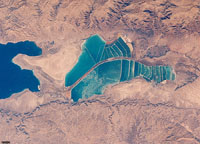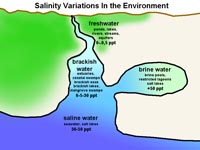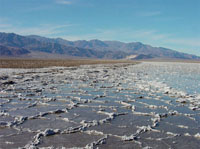7.4: Salinity
- Page ID
- 10253
Salinity
Salinity is a measure of the total amount of solid material (salts) dissolved in water, defined as:
Weight (mass) of salt
—————————— = Salinity
Weight (mass) of water
Units are described as:
• % is part per hundred (pph)
• ‰ is parts per thousand (ppt)
• Open ocean seawater ranges is 33 to 37 ‰ ppt. Average is about 35 ‰ (ppt).

Figure 7.15. Evaporation ponds constructed near the Dead Sea in Jordan are developed to manufacture salt.
Salinity is Measured by:
• electrical conductance (higher salinity = higher conductivity)
• density (higher salinity = higher density)
At room temperature, water can dissolve about 30% of its weight in salt (NaCl). Hot water can hold about 40%. A brine is water that is concentrated with high levels of salt. When evaporation concentrates salty water to it saturation point, salt crystals will precipitate.
Note that difference substances have different saturation levels in water.
Examples:
• Spring 0.3 ‰ ppt (fresh)
• Tap water 0.7 ‰ ppt (fresh)
• Limit on agriculture irrigation - 2 ‰ ppt
• Baltic Sea 10 ‰ ppt (brackish)
• Black Sea - 18 ‰ ppt (brackish)
• Average Ocean -35 ‰ ppt
• Mediterranean Sea - 38 ‰ ppt
• Red Sea 42 ‰ ppt (hypersaline)
• Great Salt Lake 280 ‰ ppt (hypersaline)
• Dead Sea 330 ‰ ppt (hypersaline)

Figure 7.17. Variations in salinity in the natural environment.
Evaporation of Seawater Results In Precipitation Of Mineral Salts
As seawater evaporates in a restricted basin seawater is concentrated becoming a brine. As evaporation proceeds various mineral salts will precipitate out in the reverse order of their solubility. Salty sedimentary deposits produced by evaporation are called evaporites. The first to precipitate is calcite (if not consumed by organisms first). Next come CaSO4 (gypsum and anhydrite varieties). This is followed by salt (NaCl) (mineral name: halite; rock name: rock salt). By volume, NaCl is the most abundant salt from seawater. The last to precipitate are potassium salts (sylvite: KCl and others) and magnesium salts (epson salt: MgSO4 and others). Various other trace salt compounds are concentrated in the last of the brine to evaporate. About 80 different salt minerals have been reportedly found in evaporite deposits.
 |
 |
| Figure 7.17. Order that salts precipitate from seawater as evaporation proceeds. | Figure 7.18. Salts forming from evaporation in Death Valley, California. |


